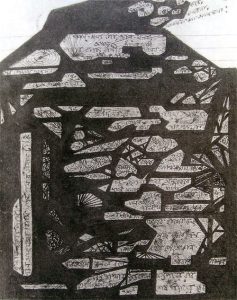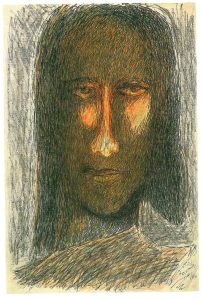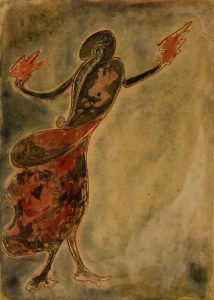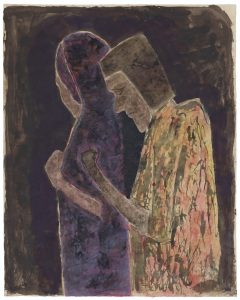Vaishnavi Srivastava
“I do not paint to create beauty, but to express my innermost self.”
-Rabindranath Tagore
Rabindranath Tagore’s progression as a painter was a reflection of his character and emotions, and his works were firmly entrenched in Indian customs while also being a part of a greater movement that resulted from the discovery of the unconscious. The acclaimed poet, playwright, and writer started creating unorthodox works of art at the age of 67 that were a reflection of his distinct personality.
Early Rabindranath Tagore drawings were erasures on manuscripts that he later referred to as “playmates.” But between 1928 and 1930, he purposefully used the unconscious level to create art that frequently appeared to be interested in animals, monsters, and men. The form as originally dictated and the subject as ultimately evolved were generally quite distinct, resulting in an art that expressed a mood of arrogant defiance.

Courtesy: Depart Magazine
It’s important to note that Tagore never professed to be a painter. He viewed painting as an outgrowth of his writing and a way to convey his thoughts and feelings in a different format. In a letter to his nephew, the artist stated, “In my paintings, I try to capture the essence of my poems and stories, to bring them to life in a new way.”

Courtesy: Sotheby’s
The use of strong, vivid colours that Tagore employed in thick layers to produce a rich, textured surface is one of his works’ distinguishing characteristics. To produce various effects, he also used unusual materials including ink, chalk, and charcoal. He painted a variety of subjects, including geometric and abstract forms, animals, people, and landscapes, but he always gave them a feeling of enigma and ambiguity.
The spiritual dimension of Rabindranath Tagore’s paintings is one of their most striking features. The ancient Hindu books known as the Upanishads, which examine the essence of reality and the human predicament, had a profound impact on him. His works frequently feature mystical or otherworldly themes that inspire thoughts of transcendence and the boundless. In the words of art critic R. Siva Kumar, “(Rabindranath) Tagore’s paintings are not just aesthetic objects but also spiritual experiences.”Siva Kumar adds that the facial characteristics depicted in Tagore’s paintings are “etched into the story of the individual” for each face they depict. If a person was wealthy or poor, or had an easy or difficult life, the figure’s distinctive contours would elaborate on those experiences.
Siva Kumar also had input on the gestures used in Tagore’s paintings. The author or playwright had mastered the language of gestures due to his 50 years of writing experience. As a result of Tagore’s writing background, his paintings had the capacity to tell a story.

Courtesy: Google arts and Culture
Tagore’s fascination with women, romantic relationships, and animals—including elephants—comes from his early experiences and his attitude towards them. Sharpness of line, rhythmic arrangement, and poetic symbolism were characteristics of his style, which connected it to Rajput painting and upheld Indian traditions. Through his efforts, Tagore reinvigorated his artwork and expressed himself through his paintings. The paintings by Tagore are a part of a larger artistic movement that originated with the study of the unconscious and includes works by Munch, Klee, and Picasso.

Courtesy: Christie’s
It’s possible that the rise of Indian nationalism sanctioned Tagore’s use of defiance. Indian discontent with foreign domination has been building over the course of the 20th century, and we can detect a loud appeal for liberation in Tagore’s artwork. Tagore’s paintings exhibit Indian expressiveness and other characteristics that have their roots in Indian traditions, and they are especially relevant to Modern India. Such forms of expression had come to a standstill in the 19th century, and Tagore was only able to breathe new life into this lifeless, decrepit art by firmly establishing his character and attitudes.
The significance of Tagore’s paintings lies more in their distinctive style than in their subjects. Since 1928, other artists have made significant contributions to Modern Indian art, but Tagore’s grandeur is obvious from the fact that Modern Indian art even exists. His effort has created a fresh foundation for future flowers to more securely be assured of their sap, and it serves as a reminder that we need to be re-educated in the essential values of art.
References
- Archer, W. G. “The Paintings of Tagore.” East and West, vol. 12, no. 2/3, 1961, pp. 147–51. JSTOR, http://www.jstor.org/stable/29754395. Accessed 8 May 2023.
- “Rabindranath Tagore’s Paintings (Human Faces, Figures and Characters) – Excerpts R Shiv Kumar.” YouTube, 28 Dec. 2020, https://youtu.be/9i9g0FgZE_g.
- “Rabindranath Tagore’s Paintings Reveal His Quest for the World beyond Words.” The Wire,thewire.in/the-arts/rabindranath-tagores-paintings-reveal-his-quest-for-the-world-beyond-words.






